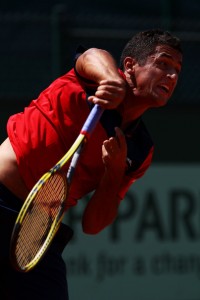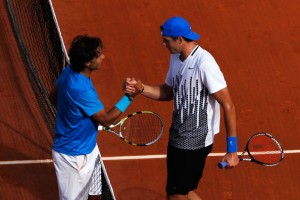Roland Garros, Day Three
(Q) Kubot d. (11) Almagro, 3/6 2/6 7/6 7/6 6/4
Of all the practical jokes recently inflicted on Nicolas Almagro, two in particular were humdingers, and it’s a nice question which of them has proved funnier. Firstly, whoever convinced him to play (and win) a minor tournament on the Cote d’Azur the week before Roland Garros should feel tremendous pride in their skills of persuasion.  It proved to be a sustained dereliction of common sense, especially given Richard Gasquet’s example from just last year, which Almagro has now replicated: a title followed by a first round upset from two sets up. That said, the second gag was arguably better. Convincing Almagro that Roland Garros had moved to a best-of-three format attests to a Loki-calibre aptitude for mischief. The look on Almagro’s face after breezing through those first two sets, only to realise he had to continue . . . Well, that was spun gold.
It proved to be a sustained dereliction of common sense, especially given Richard Gasquet’s example from just last year, which Almagro has now replicated: a title followed by a first round upset from two sets up. That said, the second gag was arguably better. Convincing Almagro that Roland Garros had moved to a best-of-three format attests to a Loki-calibre aptitude for mischief. The look on Almagro’s face after breezing through those first two sets, only to realise he had to continue . . . Well, that was spun gold.
Hopefully it is now obvious that the Open de Nice is cursed. This might seem like bad news for its organisers, but word was going to get out eventually, and there’s no reason to think this will stop players turning up. After all, the only way protect oneself from such a curse is to not play the event, which requires a level of scheduling dexterity roughly analogous to dodging an on-rushing tortoise. So far only the best of the best have proved up to it. The other thing that should be clear is that Almagro cannot reliably showcase his abilities on any stage larger than a milk crate. For all that today’s baffling loss resembled Gasquet’s from 2010, it more immediately recalled Tomas Berdych’s from yesterday, with the deft twist that Almagro was mostly ahead even in the sets he lost. Admittedly, he didn’t blow any match points, but he did blow a 3/0 lead in the fifth. He’s also blown his European clay season, again. February 2012 looks a long way off.
(1) Nadal d. Isner, 6/4 6/7 6/7 6/2 6/4
Andre Agassi’s fine autobiography Open can be appreciated on any number of levels, some more scandalous – and thus more vigorously publicised – than others. To my mind, the most engaging parts are the frequent match descriptions, since they give us Agassi at his most thoughtful, or in any case his least grandstanding. Particularly curious is the way he recounts five set encounters, employing a refreshing matter-of-factness, as though they are just like other tennis matches, the point being that once upon a time they were. Sometimes matches go to five, but the better player still wins, and it’s no big deal.  Prior to 2004, even the best players would lose sets and matches all over the place. Federer and Nadal have so recalibrated our expectations that even dropped sets are ponderously considered, each a portent of doom to come. Someone the other day was talking up Jurgen Melzer’s chances at the French Open, given that he’d almost taken a set from Nadal last year.
Prior to 2004, even the best players would lose sets and matches all over the place. Federer and Nadal have so recalibrated our expectations that even dropped sets are ponderously considered, each a portent of doom to come. Someone the other day was talking up Jurgen Melzer’s chances at the French Open, given that he’d almost taken a set from Nadal last year.
However, there is such as thing as a sense of perspective, and it is merely willful to ignore it. Rafael Nadal was today taken to five sets by John Isner, yet he never really looked in serious peril. For all that the Spaniard’s on-court celebrations were overblown, his more measured press conference suggested little relief, and more irritation that he’d spent so much longer on court than he’d wanted to. Call it arrogance, but I suspect that even at two sets to one down he didn’t feel in enormous danger, especially once he’d broken to open the fourth. He could see perfectly well that Isner’s legs had gone. Journeying further into Roland Garros 2011, the essential point to take from this match isn’t that Nadal nearly lost, since he didn’t, but that he expended much more energy than he should have. Sterner tests await.
